At a Glance
Expert’s Rating
Pros
- Expandable system grows large quantities of vegetables
- Can accommodate taller plants, including tomatoes, peppers, and vines
- App makes for foolproof farming, from sowing to harvest
Cons
- Net cups (for the seed pods) and the tray holes they go into are small
- Accessories to grow tall plants and vines cost extra
- Initial assembly is a little intimidating
Our Verdict
It’s a big investment, but money will be the last thing on your mind as you munch on the fresh vegetables you’ve grown in the Double Family Garden smart hydroponic growing system.
Best Prices Today
If you liked the Miracle-Gro Twelve Indoor Growing System we reviewed in early 2020, but want to grow larger quantities of herbs, fresh leafy greens, and other vegetables indoors and without soil, you’ll gobble up what Rise Gardens has to offer.
Updated April 5, 2022 to report new experiences after the author relocated from rural northern California to the Portland, Oregon metro area.
The $749 Double Family Garden sent for this review can accommodate up to 24 plants in its two growing trays, and you can stack a third tray ($200) on top and use high-capacity tray lids to grow up to 108 plants. The sturdy trays are fabricated from metal, but they have plastic inserts and plastic lids, both of which are easy to clean. The trays mount to a blonde wooden frame with a metal cabinet at its base. The whole system is attractive, and it looks even better once your plants have sprouted.
If $749 $879 is too much for your budget, a Single Family Garden with one tray sells for $549 $679, and it can be expanded to a Double or Triple Family Garden. There’s also a Personal Family Garden (also available from Amazon) that’s capable of growing eight to 12 plants. It sells for $279, but cannot be expanded. All three systems connect to your Wi-Fi network, and from there to a mobile app that tracks your plants’ needs—water and nutrients—and their lifespan, from planting to harvest. More on that in a bit.
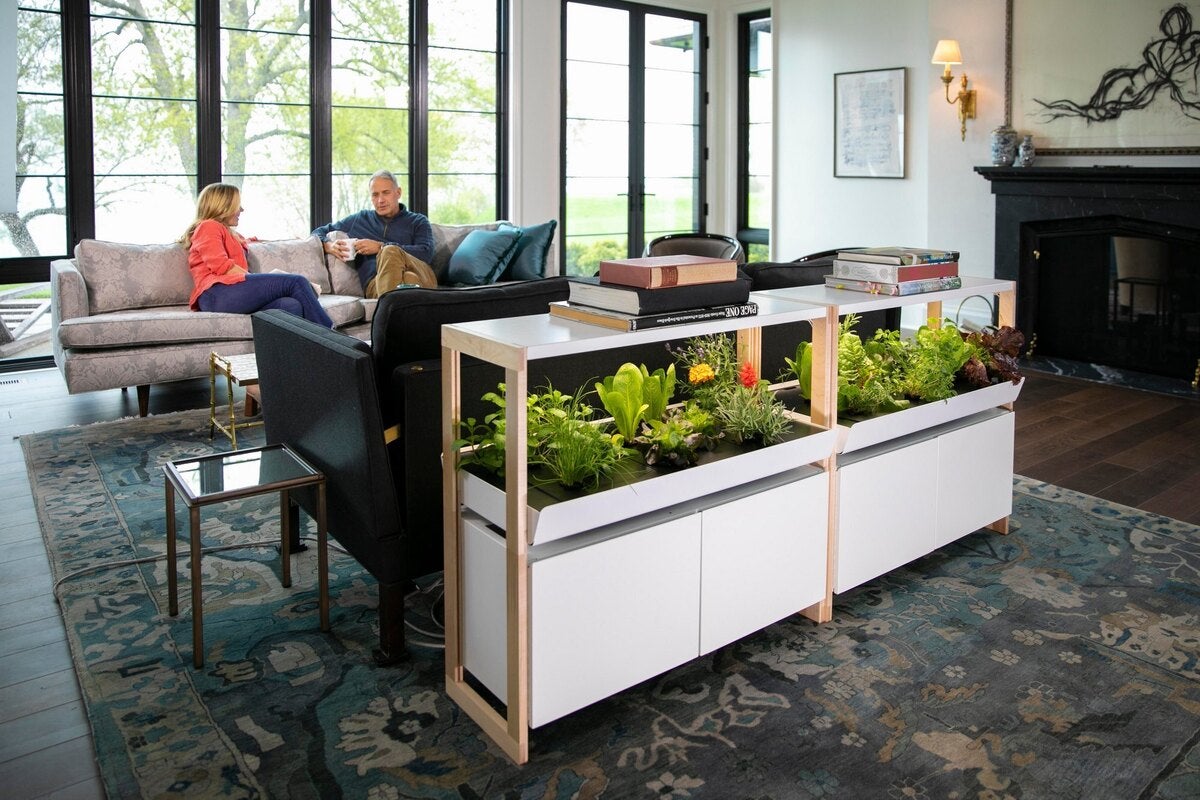
Two Single Family Gardens placed side by side. The cabinets in the base house the water tank and control board, leaving room for supplies and accessories.
The system in detail
In the double and triple models, the distance between the bottom tray and the second level is high enough to accommodate taller plants, such as tomatoes, peppers, and chard. You’re limited to growing shorter herbs and lettuces in the second and third trays. That growth height is a feature the also-expandable Miracle-Gro system doesn’t offer. A metal cabinet with twin doors in the base of the unit where you can store your supplies is another.
The system measures 36 x 16 x 52.625 inches (WxDxH). Adding the third tray increases the height to 66.25 inches. The 5-gallon water reservoir in the bottom cabinet virtually eliminates any chance that the system will topple over once it’s filled, but I wouldn’t recommend trying to move it more than a few inches once it’s in use, and only then if it’s on hard-surface flooring you can slide it across.
Full-spectrum LED grow lights are mounted in the bottom and top of the second shelf (and in the bottom and top of the third shelf with the Triple system). By default, these remain on 16 hours a day and then automatically turn off. You can also manually control—and dim—them, either by pressing a button on the right-hand door or via the app. A stack of five LED bars on this same door informs you of the water level in the reservoir and turns from green to red if the reservoir is overfilled, posing the danger of an overflow if the power should go out or the pump fail.
That submersible pump gets placed inside the reservoir in the cabinet, and it sends water up a vinyl tube (threaded through a protective ABS plastic pipe) to the highest shelf. Water circulates around the tray wetting the seed pods at this level. Once the tray is full, the water drains down to the lower level(s) through other ABS pipes until it returns to the reservoir.
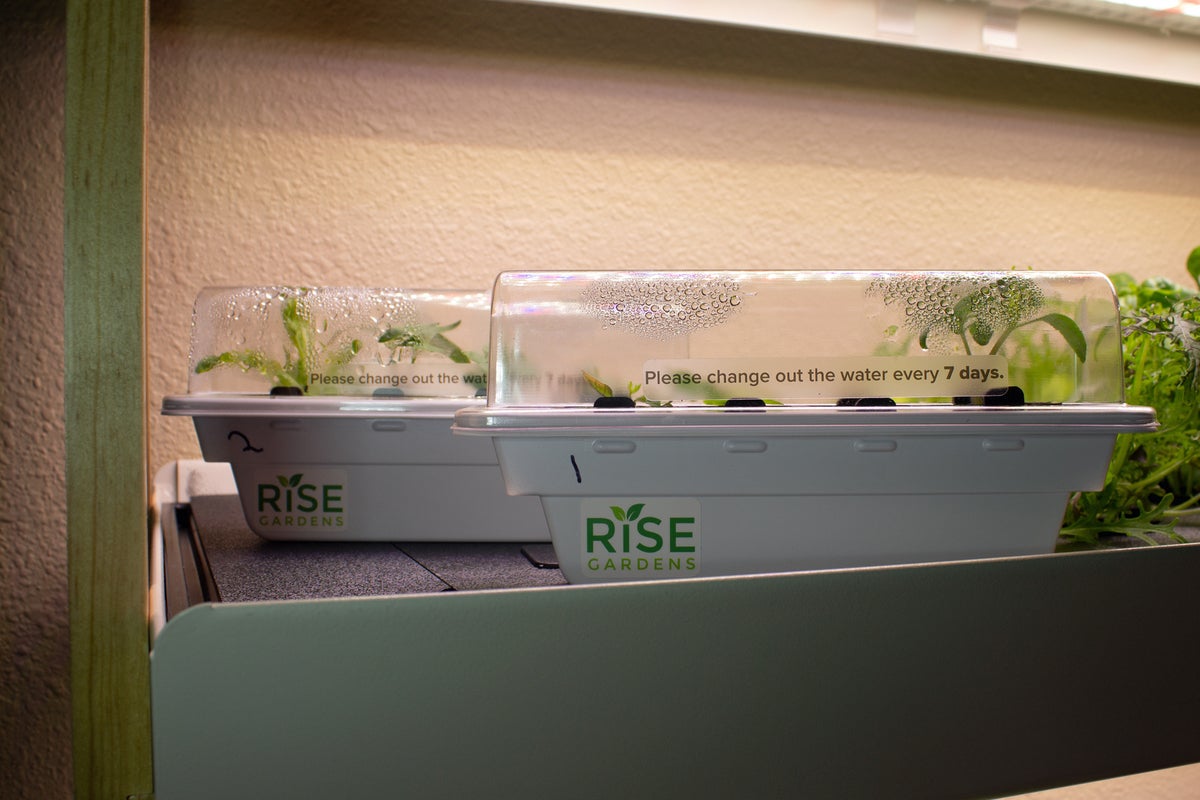
Using these nursery trays lets you sprout seedlings, increasing your production without taking up any spots in the regular growing trays.
Rise Gardens says the system (more accurately, the plants in the system, plus some evaporation) will consume about three gallons of water per week, but I found that it used far less water than that until the plants were mature. Also, growing cherry tomatoes, peppers, and Swiss chard in the bottom tray (due to their height at maturity) required a lot more water than just growing lettuces and herbs.
In the early stages of your plants’ growth, the best time to replenish the water in the system is when you feed your plants. I assembled and planted the system on a Sunday, so I added the liquid fertilizer and pH balancer treatments every subsequent Sunday, prompted by a reminder from the Rise Gardens app. I also added pH balancer whenever I added water to the system. You squirt the nutrients into the bottom tray, where the water drains into the reservoir in the base. The company recommends adding water between each application of fertilizer and pH balancer to help mix and disperse the chemicals in the water; otherwise, the nutrients will react with each other and form a solid.
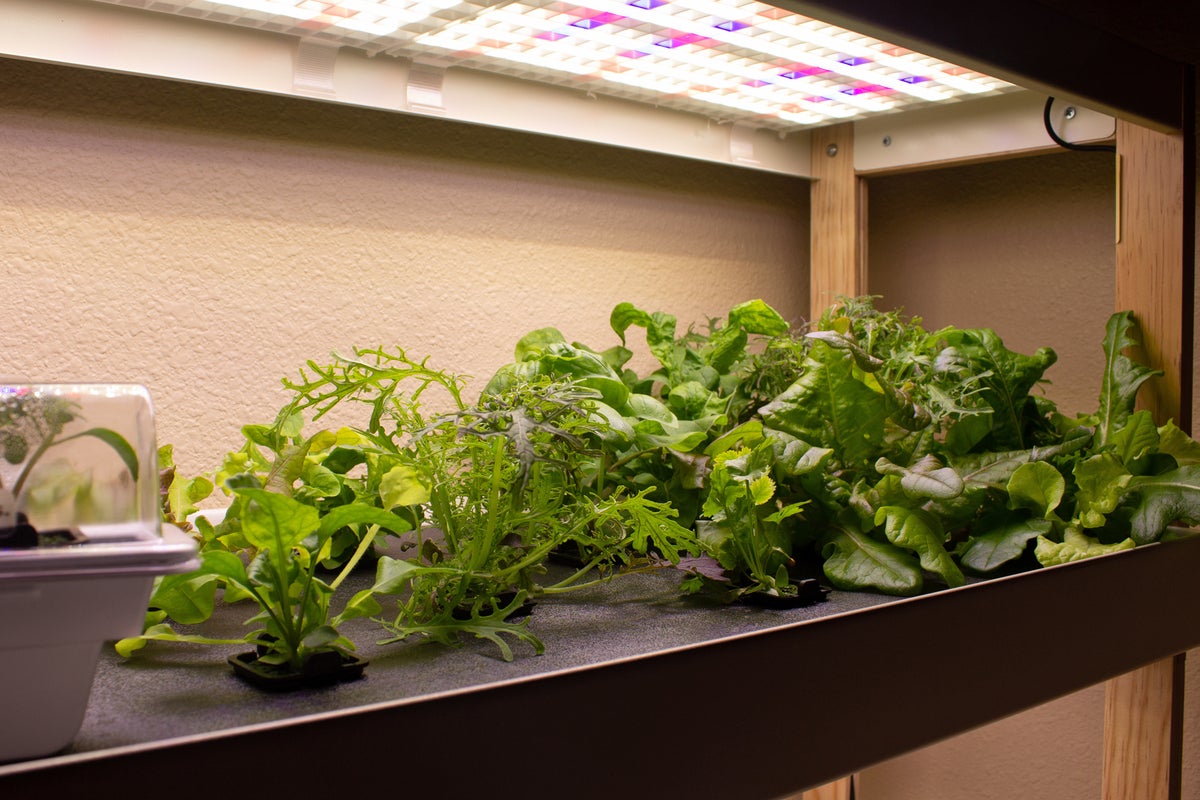
An optional higher-density tray would allow you to plant even more plants than the various lettuces and mustard shown here, although they would be much closer together.
But it can take a few minutes for the system to register the water level, so there were a couple of occasions when I slightly overfilled the system. Fortunately, I never experienced a power outage or pump failure, but I learned that it’s better to check the indicator lines printed on the reservoir as you pour in the water—and to wait a minute or two between pitchers-full—than to rely solely on the LEDs.
Comparison to the Miracle-Gro Twelve
The plastic lids you place over the trays have relatively small holes into which you’ll drop the plastic seed pods you purchase from Rise Gardens (some are included, along with enough fertilizer and pH balancer to get you started). These holes are spaced far enough apart to give lettuces and herbs plenty of room to spread out, but I found that larger plants—cherry tomatoes, in particular—grew so big that they crowded out anything I planted next to them. You can see that in some of the photos on this page. I suppose you could plant these larger vegetables in the Rise Garden and then transplant them to larger outdoor pots when the weather outside is warmer, but don’t wait too long or the roots will become too entangled with the other plants to extricate them, or they’ll become so thick that you won’t be able to pull them out of the planting hole.
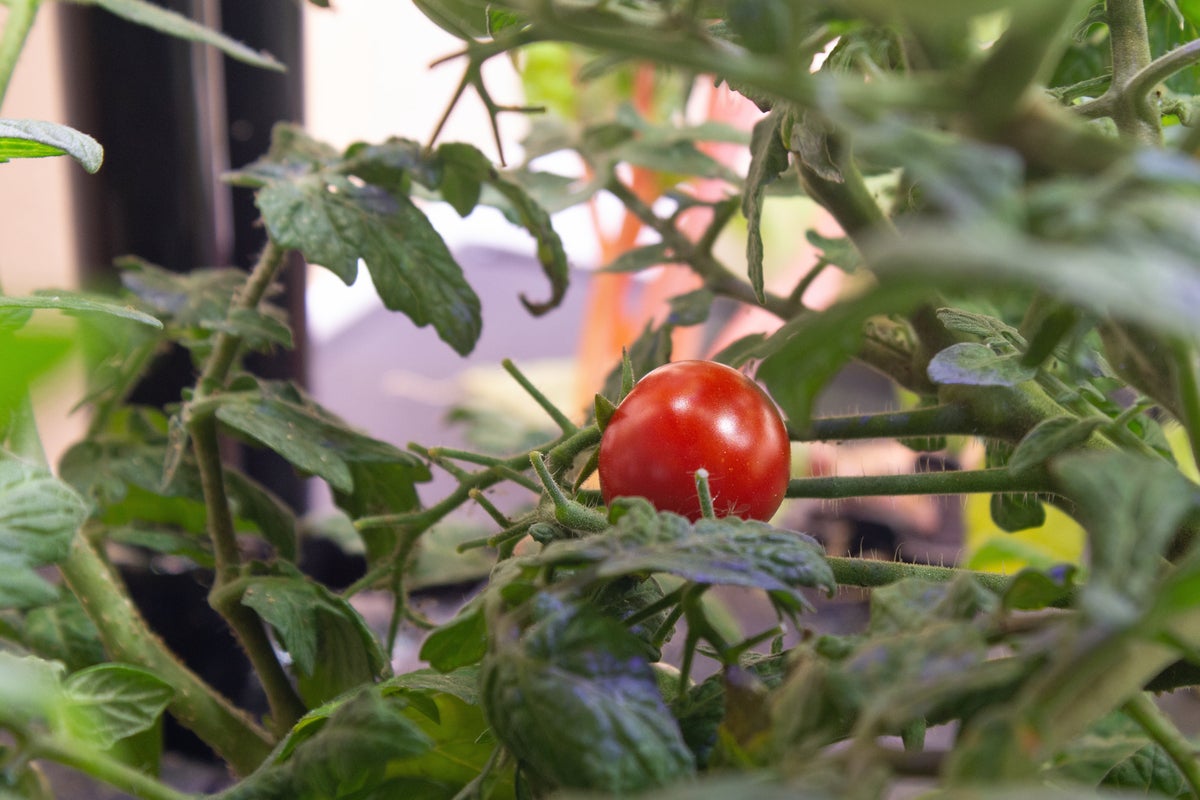
The cherry tomatoes grown in the Rise Gardens system tasted spectacular, but the plant requires lots of room to spread out.
That’s one of the features that I like about the Miracle-Gro Twelve system—it comes with two sizes of planting pods, which allows you to transplant a seedling from a small pot to a larger one. Rise Gardens does this to a much lesser degree: The system comes with small plastic trays—Rise calls them “nurseries”—that sit on top of the primary planting lids. Each nursery has a clear plastic lid that retains warmth and moisture (the seed pods sit in a pool of water, just as they will when they’re moved to the larger trays). Once the seedlings have sprouted and their leaves touch the top of the dome, it’s time to move them to the main growing trays. The advantage of this approach is that you can start your new plants much earlier without needing any more room, so that you’re never lacking for fresh greens and vegetables.
What’s included
The Double Family Garden I reviewed came with 32 seed pods: Four four-packs of lettuces, two four-packs of herbs (basil, sage, parsley, etc.), and two four-packs of larger vegetables (chard, tomatoes, peppers, and kale). There was also about a month’s word of hydroponic fertilizers and pH balancer. Considering the generally low price of average supermarket vegetables—assuming you don’t live in a food desert—buying the seed and supplies to grow your own vegetables with this system will probably be a little more expensive. But the nutrition and incredible flavor that comes from fresh-picked produce is well worth the additional cost.

Larger plants—tomato, eggplant, and peppers (shown here)—will benefit from this optional Stand Kit ($35 for three).
Four-pack seed pods for most herbs, vegetables, and lettuces cost $10 each (stevia and lavender pods cost $12.50). A category labeled Rise Reserve, which Rise Gardens says consists of hard-to-find plant varieties—costs $12.50 per four-pack. Discounts are offered for purchasing larger quantities—e.g., $24 for a 12-pack of regular herbs, veggies, and lettuces—a savings of roughly 20 percent compared to buying three four-packs.
Seed-pack subscriptions will save you even more—about 25 percent—and could be especially useful for forgetful types. Sign up and Rise will automatically send you the seed packs you want on one, two, three, or four-month intervals. You can change your selections or interval, skip an order, or cancel your subscription at any time. If you think Rise Gardens’ seed prices are too high, you can buy seedless pods at $5 per four-pack and plant anything you choose in them.
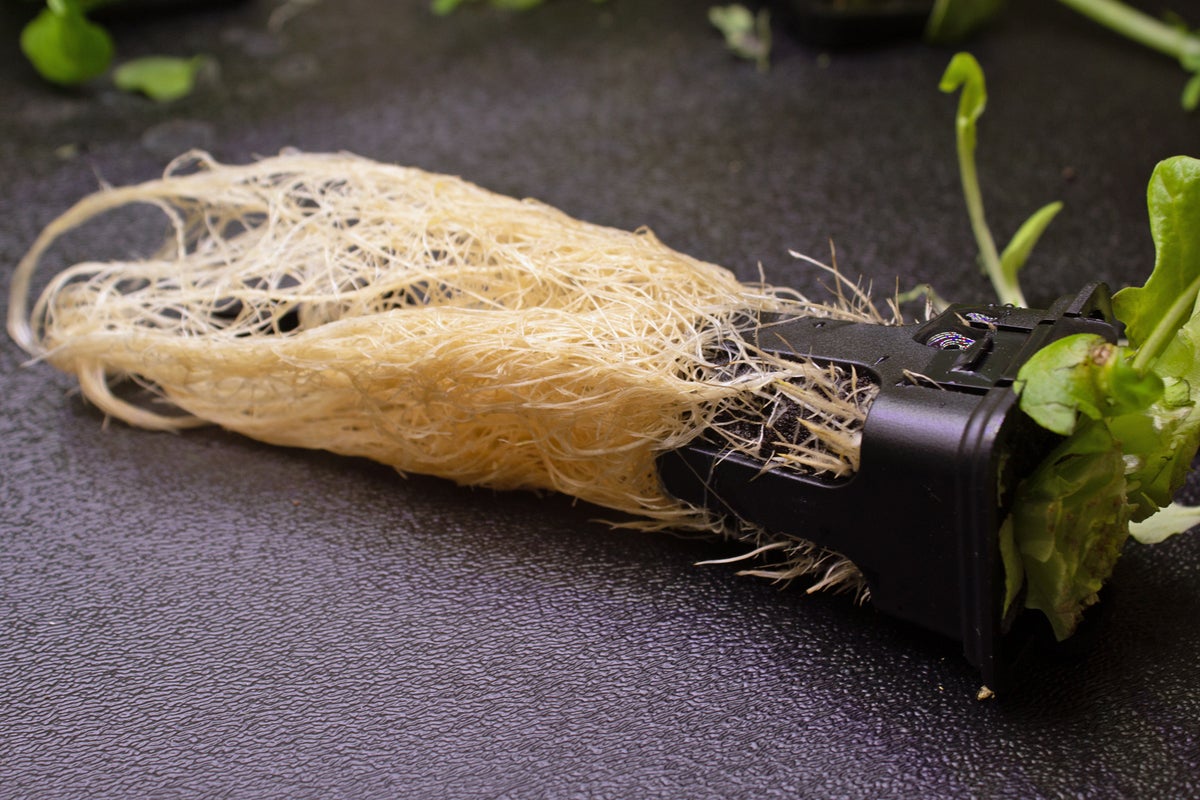
Consistently fertilizing and balancing your tap water’s pH level is essential for your plants to grow healthy roots like these.
Growing plants in the absence of soil means you’ll need to provide some liquid nutrients for the plants to thrive. As mentioned earlier, Rise includes a one-month supply with the kit. You’ll also get a strip of litmus paper for testing the pH value of your tap water. Once you enter the result in the Rise Garden app, the app will tell you how much pH balancer you’ll need to add to the water supply each week.
Three liquid fertilizers are also available—Sprout, Thrive, and Blossom—but the third is needed only for plants that will produce fruits or flowers (and is not included in the starter pack you’ll get with the purchase of the system). A 100ml bottle of pH Balance costs $15; the fertilizers come in 500ml bottles for the same price. As with the seed pods, you can save money on the price of nutrients by purchasing them on a subscription basis.
Add-on accessories
Other accessories are available but not included with the purchase of a garden system. A set of three ladder-like plant supports (the Stand Kit, $35) will prop up taller plants and vines, such as tomatoes, peppers, and eggplant (see photo above). Attach one to the seed cup when you drop it into the planting tray, and as the plant grows, you’ll use the provided ties to lash the plant’s branches to the support’s rungs. I wish I had one of these when I grew a tomato plant, because the bush got very large before it began to produce fruit. I worried that its branches might break, although they never did.
For vining plants—such as beans, cucumbers, and beans—there’s a $35 trellis kit that attaches to the garden system’s metal trays at either end using a set of magnets. As with the Stand Kit, this one comes with ties for lashing the plant’s branches to the metal trellis, so they grow vertically instead of sprawling out and crowding adjacent plants. In addition to accessories, Rise Gardens sells reasonably priced replacement parts for its garden systems, including pumps and pump mounts, vinyl tubing, foam filters, and more.
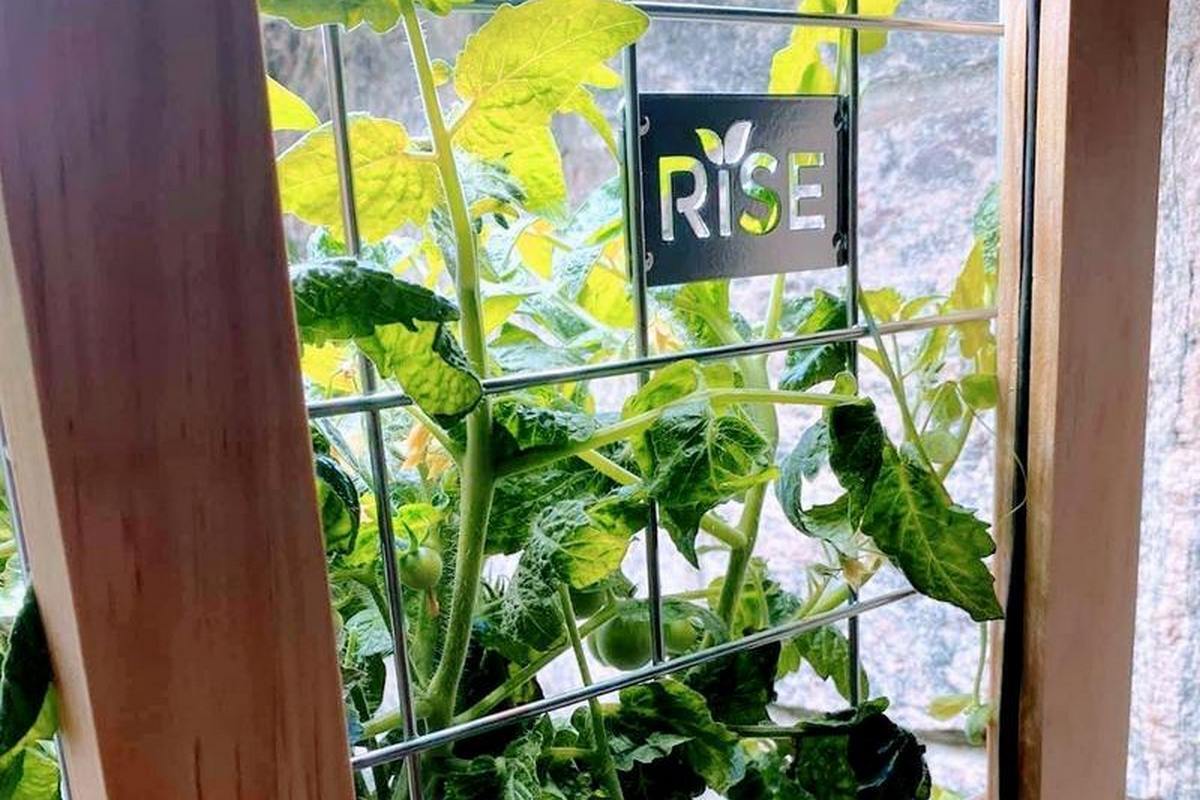
This optional trellis lets you grow vining plants, such as beans, cucumbers, and peas.
The Rise Gardens app
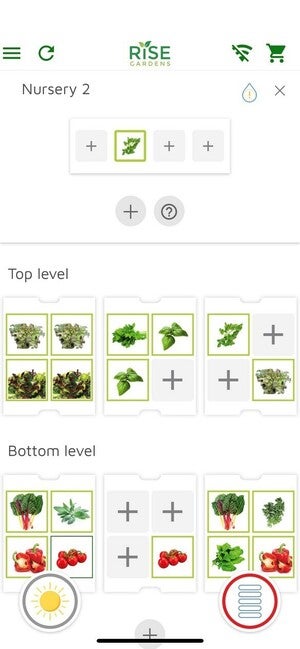
The Rise Garden app provides a map showing your garden’s layout and the status of the system’s light and water level (note that my phone wasn’t connected to Wi-Fi when I grabbed this screenshot).
The Rise Gardens app tracks the life of your plants from sprout to harvest with a map that displays which plants are in which levels or nurseries, which trays the plants are in, and even more specifically, which tray-lid holes they’re in.
Click on a given plant, and the app will display a timeline of its lifecycle, from germination in the nursery to harvest and removal from the system (some plants can be harvested more than once). The app will also report on the plant’s nutritional benefits (vitamins and minerals you’ll get from consuming it), and even how the plant can be used—complete with links to third-party recipes.
If you need to move a plant—from the nursery to a tray lid, for instance, or because it’s crowding an adjacent plant—you can easily record its new location on the map. When you harvest a plant and/or remove it from the system, you can also record that. The app will track the number of plants actively growing and how many you’ve grown over the system’s lifetime.
The also app informs you of the status of the system’s grow lights and its water level at a glance, displaying a message when the water gets low. You can dim the lights or turn them off with the tap of a button. A pop-up message will appear when it’s time to fertilize the garden and when the garden should be cleaned. You’ll get lots of other tips and suggestions as well.
Bottom line
As I discovered with the Miracle-Gro Twelve hydroponic system, using a high-tech system to grow vegetables indoors costs more than buying them at the supermarket. But growing your own food brings a sense of well-being from knowing it’s never been exposed to pesticides or other contaminants, and it’s not associated with the exploited labor used by some large-scale corporate farms.
Everything I grew matured into succulent food bursting with flavor. I raised several varieties of lettuce, arugula, mustard (for the spicy leaves), and kale. I love Swiss chard, but I never knew how good homegrown chard could taste. The peppers and cherry tomatoes, which took much longer to mature, also came out fantastic, although I would recommend purchasing the accessories to support these larger plants.
The Miracle-Gro Twelve system costs less considerably less money ($299 MSRP), but it limits you to growing four plants (eight if you stack two of them with a $30 kit, in which case the manufacturer recommends securing the system to a nearby wall). You can grow three times as many plants with the pricier Double Family Garden, and you can plant taller plants such as tomatoes, peppers, beans, cucumbers, and eggplant that the Miracle-Gro system can’t accommodate. It’s a great solution for families or anyone who likes to eat lots of fresh greens with every meal.
Eighth-month update
I relocated from rural northern California to Portland in October 2021. Downsizing from the 2,800-square-foot ranch-style home my wife and I built in 2007 to a 760-square-foot 1890 bungalow meant I no longer had room to set up the Rise Gardens Double Family Garden–at least not inside the house. I did have enough room to set the system up in my basement. While the manufacturer doesn’t recommend installing this product in unconditioned space, the mostly underground nature of a basement at least ensures the garden won’t be subject to wild swings in temperature.
My assumption has partially panned out. Some of the plants have sprouted from the seeds I sowed, and we’ve enjoyed several meals of fresh lettuces. Some of the herbs–basil, in particular–have stubbornly refused to grow, either in the nursery trays or in the larger trays. We’ve since moved some of the nursery trays inside the house, where the temperatures are more regulated. We placed them in a deep window sill, where they’ll get plenty of light during the day.
Rise Gardens has introduced many new varieties of seeds since my review, including a whole new line of “microgreens.” I haven’t tried growing any of these yet, but they look delicious. Prices for the seeds, nutrients, and garden accessories I wrote about earlier have not increased, but I can’t say the same about the garden systems themselves. The Personal Rise Garden still costs $279, but the Single Family Garden jumped from $549 to $679, and the Double Family Garden reviewed here has shot up from $749 to $879. The price of an expansion tray that can double the output of the Single Family Garden or expand the Double by one third remains the same: $200.
Earlier this month–about eight months after the system was set up–the pump that circulates water through the garden failed. I purchased the Rise Gardens DC40 Pump Assembly to replace it. This kit includes the pump itself as well as the mount for hanging it inside the water reservoir and a block of filter foam that prevents debris from being sucked into the pump. This cost $29.50 plus shipping, but the replacement pump looks to be considerably more substantial than what came with the unit. The pump can be purchased on its own for $22.50, plus shipping, but it was not available solo at the time–I’m guessing this is a supply-chain issue.
My enthusiasm for the Rise Garden hydroponic growing system remains intact, despite the price increase. This is a great system for growing delicious fresh vegetables and greens without any outdoor space–or need to get your hands dirty.

